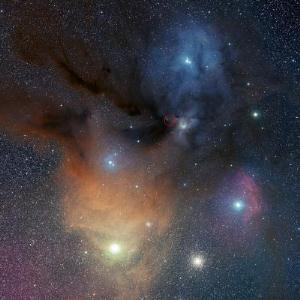 |
The colorful Rho Ophiuchi star formation region, about 400 light-years from Earth, contains very cold (around -250 degrees Celsius), dense clouds of cosmic gas and dust, in which new stars are being born. The clouds are mostly made of hydrogen, but contain traces of other chemicals, and are prime targets for astronomers hunting for molecules in space. Astronomers using the APEX telescope to observe this region discovered hydrogen peroxide molecules in interstellar space for the first time, in the area marked with the red circle. This is also a rich region for amateur observations. Rho Ophiuchi itself is the bright star near the top of the image. The bright yellowish star in the bottom left is Antares, one of the brightest stars in the sky. Below and to Antares’ right is the globular cluster Messier 4. This image of the region was obtained from the Paranal Observatory by observing with a 10-cm Takahashi FSQ106Ed f/3.6 telescope and a SBIG STL CCD camera, using a NJP160 mount. Images were collected through three different filters (B, V and R) and then stitched together. It was originally created as part of ESO’s Gigagalaxy Zoom project.
[Credit: ESO/S. Guisard] |
Now, the team has found the characteristic signature of light emitted by hydrogen peroxide, coming from part of the Rho Ophiuchi clouds.
"We were really excited to discover the signatures of hydrogen peroxide with APEX. We knew from laboratory experiments which wavelengths to look for, but the amount of hydrogen peroxide in the cloud is just one molecule for every ten billion hydrogen molecules, so the detection required very careful observations," says Per Bergman, astronomer at Onsala Space Observatory in Sweden. Bergman is lead author of the study, which is published in the journal Astronomy & Astrophysics.
Hydrogen peroxide (H2O2) is a key molecule for both astronomers and chemists. Its formation is closely linked to two other familiar molecules, oxygen and water, which are critical for life. Because much of the water on our planet is thought to have originally formed in space, scientists are keen to understand how it is created. The new discovery of hydrogen peroxide may also help astronomers understand another interstellar mystery: why oxygen molecules are so hard to find in space. It was only in 2007 that oxygen molecules were first discovered in space, by the satellite Odin.
Hydrogen peroxide is thought to form in space on the surfaces of cosmic dust grains — very fine particles similar to sand and soot — when hydrogen (H) is added to oxygen molecules (O2). A further reaction of the hydrogen peroxide with more hydrogen is one way to produce water (H2O). This new detection of hydrogen peroxide will therefore help astronomers better understand the formation of water in the Universe.
"We don't understand yet how some of the most important molecules here on Earth are made in space. But our discovery of hydrogen peroxide with APEX seems to be showing us that cosmic dust is the missing ingredient in the process," says Berengere Parise, head of the Emmy Noether research group on star formation and astrochemistry at the Max-Planck Institute for Radio Astronomy in Germany, and a co-author of the paper.
To work out just how the origins of these important molecules are intertwined will need more observations of Rho Ophiuchi and other star-forming clouds with future telescopes such as the Atacama Large Millimeter/submillimeter Array (ALMA) — and help from chemists in laboratories on Earth.
The team is composed of P. Bergman (Onsala Space Observatory, Chalmers University of Technology, Onsala, Sweden), B. Parise (Max-Planck Institute for Radio Astronomy, Bonn, Germany), R. Liseau (Chalmers University of Technology, Onsala, Sweden), B. Larsson (Stockholm University, Sweden), H. Olofsson (Onsala Space Observatory, Chalmers University of Technology), K. M. Menten (Max-Planck Institute for Radio Astronomy) and R. Gusten (Max-Planck Institute for Radio Astronomy).
ESO, the European Southern Observatory, is the foremost intergovernmental astronomy organisation in Europe and the world's most productive astronomical observatory. It is supported by 15 countries: Austria, Belgium, Brazil, the Czech Republic, Denmark, France, Finland, Germany, Italy, the Netherlands, Portugal, Spain, Sweden, Switzerland and the United Kingdom. ESO carries out an ambitious programme focused on the design, construction and operation of powerful ground-based observing facilities enabling astronomers to make important scientific discoveries. ESO also plays a leading role in promoting and organising cooperation in astronomical research. ESO operates three unique world-class observing sites in Chile: La Silla, Paranal and Chajnantor. At Paranal, ESO operates the Very Large Telescope, the world's most advanced visible-light astronomical observatory and two survey telescopes. VISTA works in the infrared and is the world's largest survey telescope and the VLT Survey Telescope is the largest telescope designed to exclusively survey the skies in visible light. ESO is the European partner of a revolutionary astronomical telescope ALMA, the largest astronomical project in existence. ESO is currently planning a 40-metre-class European Extremely Large optical/near-infrared Telescope, the E-ELT, which will become "the world's biggest eye on the sky".



